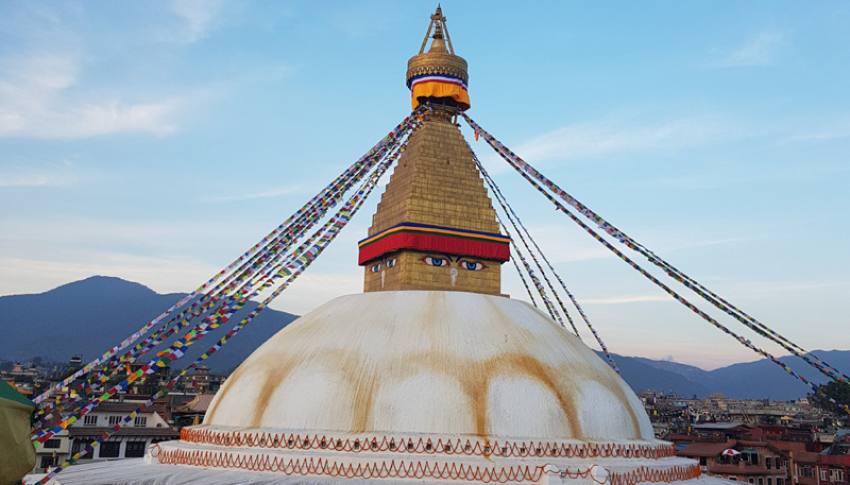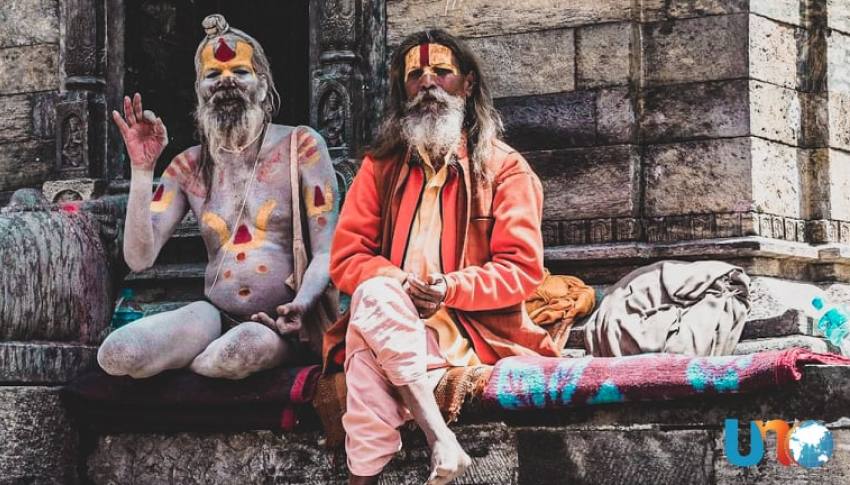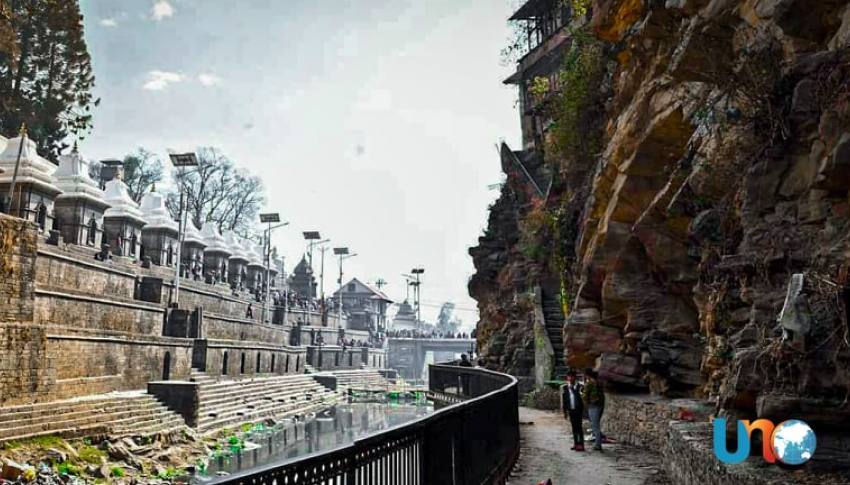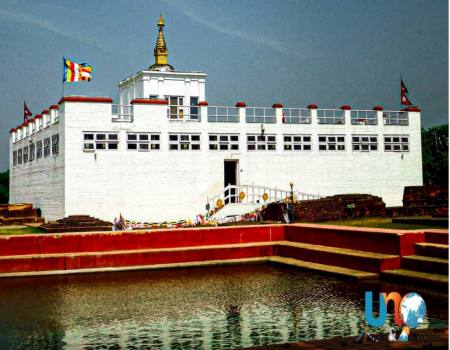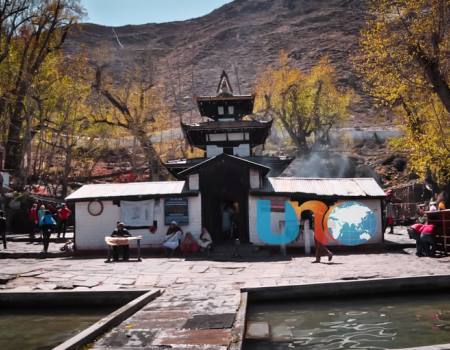Pilgrimage Tour -Kathmandu, Pokhara and Janakpur Dham
Kathmandu
Swayambhunath
Swayambhunath stupa is situated in Kathmandu District. It is a very important place of Nepal and it is famous for all over the world. It is related to the Buddhist philosophy. It is ancient Mahachaitya in Katmandu District. It is made by Lichchhabi king Mandev in the 5th century. It's made of mud and bricks. It is a white wash with outside. There are nine golden Molamba with small temples around circular Mahachaitya. Among the five Panchayani Buddhas and their vehicles and stars are situated in its lower parts. Among the five Buddhas, the major stupa of Amitav and its vehicle, Peacock is in the west. Similarly, Amoghsidhi and its vehicle Garud, Achovya and its vehicle Elephant, Bairochan and its vehicle Lion and Ratna Stambha and its vehicle horse are around Amitav Stupa. In the great stupa, Bairochan Buddha's two eyes are kept in four sides in upper parts and in lower parts Buddha's ways and Pancharatna's tika in middle parts. The symbol of peace eye with triangle is called Harmika. Pancha Buddha's statues are inscribed in its four sides. Similarly, it is notified in world heritage site in 1979 AD.
Pasupatinath Temple
Pashupatinath is the holiest Hindu pilgrimage destination in Nepal. There are linga images of Shiva along with statues, shrines, and temples dedicated to other deities in the complex. A temple dedicated to Shiva existed at this site in AD 879. However, the present temple was built by King Bhupatindra Malla in 1697 AD. A gold-plated roof, silver doors, and woodcarvings of the finest quality decorate the pagoda construction. Guheswari Temple, restored in AD 1653, represents the female "force". It is dedicated to Satidevi, Shiva's first wife, who gave up her life in the flames of her father's fire ritual. A circuit of the Pashupati area takes visitors past a sixth-century statue of the Buddha, an eighth-century statue of Brahma the creator and numerous other temples. Some other places to visit are Rajrajeswari Temple, built in 1407, Kailas with lingas more than 1,400 years old, Gorakhnath temple, and the courtyard of Biswarup. There are rows of Shiva shrines and Hindu pilgrims from all over South Asia offering puja worship to Shiva, tile Lord of Destruction.
Bhaktapur Durbar Square
Bhaktapur Durbar Square is the plaza in front of the royal palace of the old Bhaktapur Kingdom, 1400m above sea level. It is a UNESCO World Heritage Site. The Bhaktapur Durbar Square is located in the current town of Bhaktapur, also known as Bhadgaon, which lies 13 km east of Kathmandu. While the complex consists of at least four distinct squares (Durbar Square, Taumadhi Square, Dattatreya Square and Pottery Square), the whole area is informally known as the Bhakapur Durbar Square and is a highly visited site in the Kathmandu Valley.
Bouddhanath
Bouddhanath is one of the largest stupa among the stupas in South Asia, and it has become the focal point of Tibetan Buddhism in Nepal. The white mound looms thirty-six meters overhead. The stupa is located on the ancient trade route to Tibet, and Tibetan merchants rested and offered prayers here for many centuries. When refugees entered Nepal from Tibet in the 1950s, many of them decided to live around Bouddhanath. They established many gompas, and the "Little Tibet" of Nepal was born. This "Little Tibet" is still the best place in the Valley to observe Tibetan lifestyle. Monks walk about in maroon robes. Tibetans walk with prayer wheels in their hands, and the rituals of prostration are presented to the Buddha as worshippers circumambulate the stupa on their hands and knees, bowing down to their lord.
Kathmandu Durbar Square
Kathmandu Durbar Square (Basantapur Durbar Kshetra) in front of the old royal palace of the former Kathmandu Kingdom is one of the biggest Durbar square among three durbar (royal palace) Squares in the Kathmandu Valley in Nepal, all of which are UNESCO World Heritage Sites. Several buildings in the Square collapsed due to a major earthquake on 25 April 2015.The Durbar Square is surrounded with spectacular architecture and vividly showcases the skills of the Newar artists and craftsmen over several centuries. The Royal Palace was originally at Dattaraya square and was later moved to the Durbar square. The Kathmandu Durbar Square held the palaces of the Malla and Shah kings who ruled over the city. Along with these palaces, the square surrounds quadrangles, revealing courtyards and temples. It is known as Hanuman Dhoka Durbar Square, a name derived from a statue of Hanuman, the monkey devotee of Lord Ram, at the entrance of the palace.
Pokhara
Phewa Lake
Phewa Tal is the travellers focal point in Pokhara, and is the second largest lake in Nepal. In contrast to the gaudy tourist development of Lakeside, the steep southwestern shore is densely forested and alive with birdlife. The lush Rani Ban, or Queen’s Forest, bestows an emerald hue to the lake, and on a clear day, the Annapurna mountain are perfectly reflected on its mirror surface. Brightly painted doongas (boats) are available for rent at Lakeside for boating. Many people walk or cycle around the lakeshore – the trek up to the World Peace Pagoda affords breathtaking views over the tal to the mountains beyond.
Mahendra Cave
The cave gets its name from former King, Mahendra Bir Bikram Shah Dev. This cave was discovered in the late 1950's by young shepherds of Pokhara. Since then it has remained one of the most visited places in Pokhara. Mahendra Cave is located in the city of Pokhara in the western region of Nepal. The cave can be accessed by the visitors from Pokhara. The canal is completely dark with continuously dripping water overhead. The cave is full of limestone, which falls to the ground and continuously forms electrical sparks. Due to the darkness, artificial lighting is provided inside the cave.
Chamero Gufa
Chamero Gufa is one of the famous places at pokhara valley. It is western side of the pokhara valley, it is named, Chamero Gufa because of the cave's walls and ceiling is full of Bats. there is no access of any natural light inside the cave so there is the facilities of torch light for the visitors. It is a long cave and it might frighten due to it's darkness. inside there we can feel the sound of water fall and even we can see the water fall of David's fall. it is one of the most adventurous and beautiful tourist destination.
Tal Barahi Temple
Tal Barahi Temple, also known as Lake Temple or Barahi Temple is a two story pagoda temple located in the middle of lake Phewa, Kaski District of the Gandaki Zone in western Nepal. It is a hindu temple of the Goddess Durga (Barahi), the protector of gods. The temple is used for worshiping by both Hindus and Buddhists. There are many stories based on the establishment of the temple. One of them is described below. The temple was above the lake before King Kulmandhan Shah (The first Shah king of Kaski) according to the dream he had seen. The great devotee of Goddess Durga, King Kulmandhan Shah constructed the temple in the middle island of Lake Phewa.
Devis Falls
Davis Falls is a waterfall located in Pokhara, Kaski District, Nepal. The water forms an underground tunnel after reaching the bottom. This tunnel is approximately 500 feet (150 m) long and runs 100 feet below ground level. On 31 July 1961, a Swiss couple Davis went swimming but the woman drowned in a pit because of the overflow. Her body was recovered 3 days later in river Phusre with great effort. Her father wished to name it "Davi's falls" after her. Its Nepali name is Patale Chango, which means "underworld waterfall". After exiting the tunnel, the water passes through a cave called Gupteshwor Mahadev or "cave beneath the ground". The Phewa Lake dam is the water source. It is an attraction for tourists and locals. Thousands of Nepalese visit for recreation and enjoyment. Visitors can try their luck on the luck pond constructed there by throwing and placing the coin on the statue of god. Likewise, one can find a model of traditional typical Nepali house and a series of statue of Nepali people wearing traditional dresses where visitors can click photo.
Janakpur Dham
Janakpur is the capital of the ancient state of Mithila and the Janaki Temple, located in the center of the city, is well known in the Hindu Kingdom. Sita the wife of the legendary hero Ram was born in Janakpur. Throughout the year, many pilgrims come to pay their respects to Ram and Sita who are the main religious attractions in Janakpur. The city is thronged by worshipers and visitors alike especially during the festival of Bibah Panchami. This annual festival is celebrated on the occasion of Ram and Sita's marriage and their wedding ceremony is enacted throughout the week. During this period, the city is enlivened by the wedding festivities. Ram and Sita (Janaki) are the two central characters of the great Hindu epic Ramayan. In the story, Ram strings a bow that originally belonged to Lord Shiva the Destroyer and in the process; the bow breaks into three pieces. One piece flies up to heaven. Another falls down into the depths of the underworld. Today, there is a huge pond called Dhanush Sagar above the very spot. The third piece flies to present day Dhanushadham, about 40 kilometers from Janakpur. There, visitors will see huge rocks shaped liked a bow. Thus, after Ram's successful attempt to string the bow, Janaki's father, King Janak gives his daughter's hand in marriage to the brave prince of Ayodhya.
Trip Highlights
- Fully support for tourist bus, full service including all lounging and meals.
- All religious places information by the tour guide.
- Historical heritage and pilgrimage places tours.
- Different types of nature, culture, religion, ethnic group and landscape.
Outline Itinerary
- Day 01:Airport to hotel
- Day 02:Kathmandu tour (Swayambhunath, Pasupati, Bhaktapur Durbar square, Baudhanath Stupa and Durbar Square)
- Day 03:Kathmandu to Poakhara (198 km)
- Day 04:Pokhara tour ( Phewa lake, Mahedra Cave, Chamero Gufa, Talbarahi Temple and Debit Fall)
- Day 05:Pokhara to Janakpur (360 km) (Kathmandu to Janakpur 378 km)
- Day 06:Janakpur tour
- Day 07:Janakpur to Kathmandu
- Day 08:Departure from Kathmandu.
Detail Itinerary
- Day 1Airport to hotel
- Day 2Kathmandu tour (Swayambhunath, Pasupati, Bhaktapur Durbar square, Baudhanath Stupa and Durbar Square)
- Day 3Kathmandu to Poakhara (198 km)
- Day 4Pokhara tour ( Phewa lake, Mahedra Cave, Chamero Gufa, Talbarahi Temple and Debit Fall)
- Day 5Pokhara to Janakpur (360 km) (Kathmandu to Janakpur 378 km)
- Day 6Janakpur tour
- Day 7Janakpur to Kathmandu
- Day 8Departure from Kathmandu.
What's Includes:
- Full board services during tour and tour guide.
- All necessary paper works.
- All government and local taxes.
What's Excludes:
- Personal gears and clothing. Tips, alcohol any expenses of personal nature.
Trip Note
Nepal is full of varieties of people, languages, cultures, and traditions. There live altogether 103 castes and ethnic groups. More than 93 languages are spoken here. Aryan and Mongolian people are common races. The Mongolian races are divided into many ethnic groups. Such as Limbu, Rai, Tharu, Tamang, Gurung, Magar, Sherpa, Newar etc. are Mongolian races ethnic people and Brahmin, Chhetri and Dalits are caste groups. Nepal is a secularist country. Buddhism, Hindu, Islamism, Christianity, Jainism, Sikhism, Kirat, Bahai etc. are major religions. Physically Nepal can be divided into three regions. They are Tarai, Hilly, and the Himalayan region. Nepal is rich in historical religion heritages, cultures, languages, traditions, festivals and natural beauty.
Quick Inquiry
Trip Facts
- Transportation:12
- Meals:Breakfast + Lunch + Dinner
- Accommodation:Lodge to lodge
